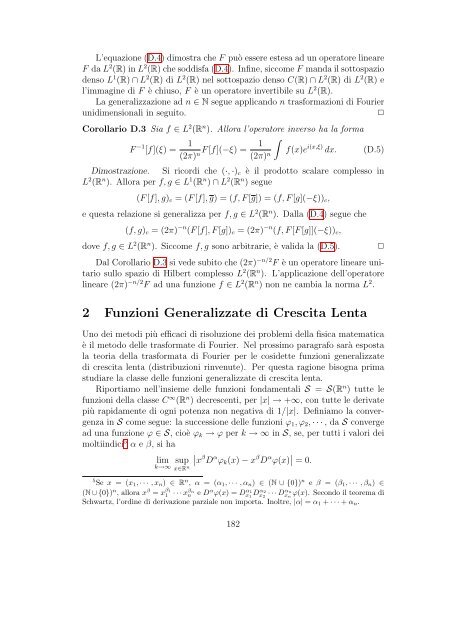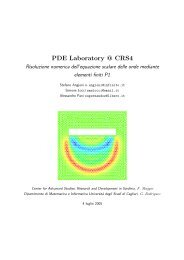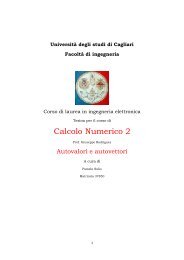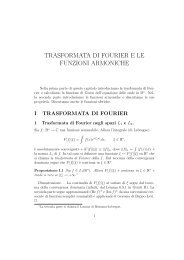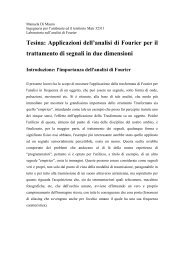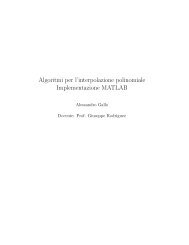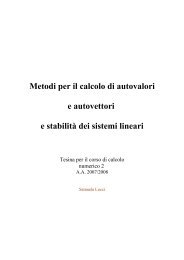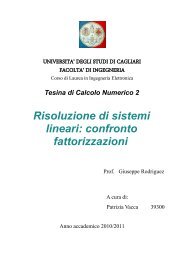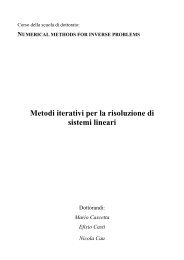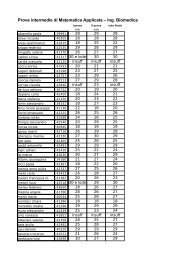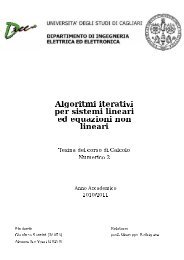ISTITUZIONI DI FISICA MATEMATICA Corso di 6 Crediti Corso di ...
ISTITUZIONI DI FISICA MATEMATICA Corso di 6 Crediti Corso di ...
ISTITUZIONI DI FISICA MATEMATICA Corso di 6 Crediti Corso di ...
You also want an ePaper? Increase the reach of your titles
YUMPU automatically turns print PDFs into web optimized ePapers that Google loves.
L’equazione (D.4) <strong>di</strong>mostra che F può essere estesa ad un operatore lineareF da L 2 (R) in L 2 (R) che sod<strong>di</strong>sfa (D.4). Infine, siccome F manda il sottospaziodenso L 1 (R) ∩ L 2 (R) <strong>di</strong> L 2 (R) nel sottospazio denso C(R) ∩ L 2 (R) <strong>di</strong> L 2 (R) el’immagine <strong>di</strong> F è chiuso, F è un operatore invertibile su L 2 (R).La generalizzazione ad n ∈ N segue applicando n trasformazioni <strong>di</strong> Fourieruni<strong>di</strong>mensionali in seguito.✷Corollario D.3 Sia f ∈ L 2 (R n ). Allora l’operatore inverso ha la formaF −1 [f](ξ) = 1(2π) F [f](−ξ) = 1 ∫f(x)e i(x,ξ) dx. (D.5)n (2π) nDimostrazione. Si ricor<strong>di</strong> che (·, ·) c è il prodotto scalare complesso inL 2 (R n ). Allora per f, g ∈ L 1 (R n ) ∩ L 2 (R n ) segue(F [f], g) c = (F [f], g) = (f, F [g]) = (f, F [g](−ξ)) c ,e questa relazione si generalizza per f, g ∈ L 2 (R n ). Dalla (D.4) segue che(f, g) c = (2π) −n (F [f], F [g]) c = (2π) −n (f, F [F [g]](−ξ)) c ,dove f, g ∈ L 2 (R n ). Siccome f, g sono arbitrarie, è valida la (D.5).Dal Corollario D.3 si vede subito che (2π) −n/2 F è un operatore lineare unitariosullo spazio <strong>di</strong> Hilbert complesso L 2 (R n ). L’applicazione dell’operatorelineare (2π) −n/2 F ad una funzione f ∈ L 2 (R n ) non ne cambia la norma L 2 .2 Funzioni Generalizzate <strong>di</strong> Crescita LentaUno dei meto<strong>di</strong> più efficaci <strong>di</strong> risoluzione dei problemi della fisica matematicaè il metodo delle trasformate <strong>di</strong> Fourier. Nel prossimo paragrafo sarà espostala teoria della trasformata <strong>di</strong> Fourier per le cosidette funzioni generalizzate<strong>di</strong> crescita lenta (<strong>di</strong>stribuzioni rinvenute). Per questa ragione bisogna primastu<strong>di</strong>are la classe delle funzioni generalizzate <strong>di</strong> crescita lenta.Riportiamo nell’insieme delle funzioni fondamentali S = S(R n ) tutte lefunzioni della classe C ∞ (R n ) decrescenti, per |x| → +∞, con tutte le derivatepiù rapidamente <strong>di</strong> ogni potenza non negativa <strong>di</strong> 1/|x|. Definiamo la convergenzain S come segue: la successione delle funzioni ϕ 1 , ϕ 2 , · · · , da S convergead una funzione ϕ ∈ S, cioè ϕ k → ϕ per k → ∞ in S, se, per tutti i valori deimoltiin<strong>di</strong>ci 5 α e β, si halim sup∣ x β D α ϕ k (x) − x β D α ϕ(x) ∣ = 0.k→∞ x∈R n5 Se x = (x 1 , · · · , x n ) ∈ R n , α = (α 1 , · · · , α n ) ∈ (N ∪ {0}) n e β = (β 1 , · · · , β n ) ∈(N ∪ {0}) n , allora x β = x β11 · · · xβn n e D α ϕ(x) = Dx α11Dx α22 · · · Dx αnnϕ(x). Secondo il teorema <strong>di</strong>Schwartz, l’or<strong>di</strong>ne <strong>di</strong> derivazione parziale non importa. Inoltre, |α| = α 1 + · · · + α n .182✷


